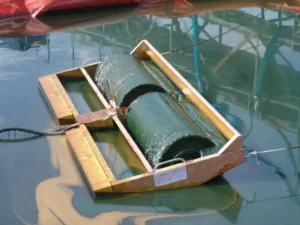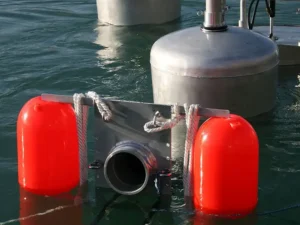The marine industry, consisting of ships and vessels, uses oil for its operations. Those vessels consume large amounts of oil and can produce oil spills. Draining this waste oil into the ocean would be a worse idea. We can save water from this oil by using different types of oil skimmers.
Knowing that this oil forms a layer on the water’s surface is essential. The oil layer stops the supply of oxygen and sunlight to marine animals, resulting in many animal deaths. However, we can minimize this risk by skimming.
But the skipping process is least understood. Various types of skimmers are available. It is essential to recognize each type and use it accordingly. This detailed article will explore all those types and how they work. So, let’s get rolling!
Overview of Oil Skimming

Specific gravity is one of the principles on which skimming works. Need to know specific gravity? It is a ratio of density between two fluids. One is general fluid, and the other is reference fluid. The reference fluid for liquids is water.
The skimming process uses heavy-duty skimmers. These machines collect oil and separate it from fluid or water. Their usability standard is accessible to different oil refineries. These skimmers play a crucial role in removing the oil from the water during skimming.
Marine industries produce waste oil and hydrocarbons with lower specific gravity. For example, large ships can spill the oil due to malfunctioning. When waste oil is thrown into oceans, it starts floating on the surface, the first and primary stage of oil separation.
Surface tension is a property that makes skimming possible. This property holds the molecules of the liquid tightly together. When oil is drained in water, the surface tension does not allow the oil to sink, so the oil remains at the water’s surface.
This is where the skimmers come into play. They benefit from surface tension and collect the oil at the surface, as the surface does not let it sink. In this regard, oleophilic(oil-loving) skimmers come in handy. They show love and adherence to oil, leaving the water undisturbed.
Types of Oil Skimmers
As I said, skimmers play a crucial role in separating and removing oil from the water surface. Without them, the process of skimming would be incomplete. There are two main types of oil skimmers:
- Oleophilic (oil lover)
- Oleophobic (oil hatter)
Further, each has different subtypes. We will discuss each of those subtypes in the section below.
1- Disc Skimmers (Oleophilic)
Disc skimmers contain a large number of discs to attract oil. However, some disc skimmers have single discs. The quantity of oil that undergoes separation determines its use. Disc oil skimmers ideally work for low to medium-viscosity oil. They can also work in the open sea to save the lives of marine animals.
Let’s find out how these skimmers work. Disk skimmers are oleophilic, which means they only attract oil, not water. When put into the open sea, a disc skimmer starts spinning. The oil sticks to the disc, leaving the water behind. These discs keep spinning repeatedly until they gather a large amount of oil.
2- Drum Skimmers (Oleophilic)

Drum skimmers are activated by hydraulics and wind power. The companies use them in dangerous places like the middle of the ocean. With the help of drum skimmers, you can quickly separate gallons of diesel and crude oil.
Like disc skimmers, drum skimmers are oleophilic. They consist of large drums that are connected to electricity to rotate. When they start spinning, these large drums attract oil. Specialized small machines remove oil from each drum.
This oil is gathered into a tank. Now, they are ready for a new turn of rotation. The primary use of these drum skimmers is in marine settings where they separate large amounts of oil.
3- Belt Skimmers (Oleophilic)
Belt skimmers consist of particular types of belts. These belts have a simple design and are wrapped in a loop. Large companies apply these skimmers to large water bodies like oceans and small lakes.
However, Marine industries use them near beaches with little water. Belt skimmers work on the principle of surface tension. As I have said above, water and oil have different surface tensions, and these skimmers take advantage of this difference.
When you give it a power supply, the belt starts spinning. The belt comes out of the loop, collects oil, pours it into the tank, and goes again. Repeating the process collects a large amount of oil.
4- Tube Skimmers (Oleophilic)
Tube skimmers are the best choice for collecting oil from the ocean shore. These skimmers consist of large tubes closed by one end. These tubes only work in low waters. The plus point of these skimmers is that they can work long without stopping.
Moreover, you only need a little energy supply for work. As I said, special tubes that attract only oil make up tube skimmers. They use the same principle of surface tension. The tube starts spinning and sticks oil during each rotation. Technical Suckers are attached to tubes that collect the oil from the tube after every round.
5- Brush Skimmers (Oleophilic)
The brush skimmers are made of special brushes made of unique and robust material. The best thing about these skimmers is that they can bear the shocks of spirals. Therefore, they are used in deep oceans to clean them from oil. They can pick up both heavy and light oil.
These skimmers are oleophilic. They rotate to collect oil from the surface of the water. After every rotation, oil is collected in the container. The brushes are rinsed away and sent back for further oil collection. These skimmers are highly efficient and collect oil quickly.
Quick Highlight: These skimmers are very effective in the deep oceans, as they can withstand the load of waves. Many marine life, such as fish, can be saved in this area. Moreover, these skimmers have different sizes, and the company can use them per their needs.
6- Suction Skimmers (Oleophobic)
Have you seen a vacuum cleaner? Suction skimmers are just like them. They consist of high-powered pumps that suck the oil in large quantities. Manufacturers design these skimmers for ships, vessels, cruises, and the oil refinery industry.
Above all, they can collect both heavy oil(crude oil) and light oil( diesel). You can set their suction according to each oil. Moreover, they are easy to use because of their models. I have stated above that these skimmers work on the principle of vacuum cleaners.
They contain a big pump that produces suction. You can adjust the suction power according to oil types. When the suction head is dropped into water, it sucks the oil from the surface as well as from deep down. When it comes out of the water, it contains a large quantity of oil.
7- Weir Skimmers (Oleophobic)

Weir means “barriers.” As their name means, these skimmers consist of unique barriers. These barriers collect oil from the water. These skimmers are practical in peaceful waters, which means you can effectively use them to clear the beaches and shores of oil.
The main advantage of these weir skimmers is that they have elementary components that are easy to clean and mend. The weir skimmers use the principle of gravity to work. As mentioned above, they consist of barriers. They have a special gravity effect on oils.
These barriers collect the oil and send it to the special compartment for collection. On the flip side, water slides over the barrier and almost recovers. Weir skimmers are oleophobic. They collect water with oil, too, so they can take extra time to remove water from the oil. In short, these skimmers can work more slowly compared to other types.
Why Does the Marine Industry Need Oil Skimmers?
Almost all industries use oil for their operations. The marine industry is no exception, as ships and vessels use a large amount of oil. Moreover, many other machines consume it. However, their league and spill can put large amounts of oil into the water. However, throwing any fluid in open water containing oil contaminants is illegal.
It is dangerous for human health and depletes the natural environment. Therefore, to remove that oil, the marine industry uses oil skimmers for their benefit. Moreover, oil refineries also use them to purify the oils. Keep in mind those references produce impure oil. Its purification is critical, and industries use skimmers for this purpose.
It won’t be wrong to say that marine industries consider skimmers a must-have. They use most of the advanced skimmers. First, they need skimmers for their ships. Crude oil can damage the integral parts of the vessels, which can cause serious accidents. Moreover, if the marine industries do not use oil skimmers, they will cause serious environmental problems.
Frequently Asked Questions
How many types of skimmers are there?
There are seven common types of skimmers. Each type has a specific working principle. Moreover, each type is specific for working in different environments.
Which skimmer is suitable for heavy oil?
A suction skimmer and belt skimmer are used to clean heavy oil. They have specialized machinery that helps them remove heavy oil from water bodies.
What is an oil skimmer device?
An oil skimmer is a device that separates oil from water. It is used in various industries, such as oil refineries and marine sectors.
What is the principle of an oil skimmer?
The oil skimmer machine works using the principle of gravity and surface tension. Oil has lower surface tension than water, so it starts floating on the surface. These machines collect this oil layer from the surface.
Conclusion
Pollution is a significant issue, and its impact also affects marine life. If the oil remains in the water, it will affect aquatic life. But skimmers are the real savior in this situation, saving our planet from pollution. In this article, I have covered almost all types of skimmers.
Skimmers come in all types, from simple to advanced. They reduce human efforts to keep the environment clean and are available in all sizes. You can use different types of oil-cleaning methods on beaches and even deep in the ocean.
